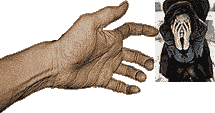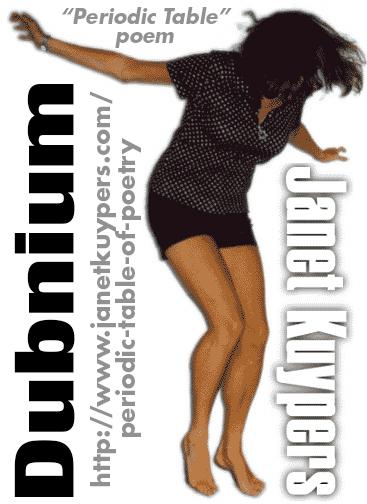
[the Writing of Kuypers] [JanetKuypers.com] [Bio] [Poems] [Prose]

Watch YouTube video of Janet Kuypers reading this Periodic Table poem Dubnium in her Visionaries Behind the Stars feature, live in Chicago 9/12/14 at “Poetry ‘Love Letter’” (C) |

Watch YouTube video of Janet Kuypers reading this Periodic Table poem Dubnium in her Visionaries Behind the Stars feature, live in Chicago 9/12/14 at “Poetry ‘Love Letter’” (S) |
 See YouTube video of poems read from Janet Kuypers’ brand new Periodic Table of Poetry series in Visionaries Behind the Stars, live in Chicago 9/12/14 at “Poetry ‘Love Letter’” (this video was filmed from a Canon camera; posted on Facebook, Twitter, Linkedin, Pinterest, Instagram, & Tumblr).� #janetkuypers #janetkuyperspoetryshow
See YouTube video of poems read from Janet Kuypers’ brand new Periodic Table of Poetry series in Visionaries Behind the Stars, live in Chicago 9/12/14 at “Poetry ‘Love Letter’” (this video was filmed from a Canon camera; posted on Facebook, Twitter, Linkedin, Pinterest, Instagram, & Tumblr).� #janetkuypers #janetkuyperspoetryshow
|
 See YouTube video of poems read from Janet Kuypers’ Periodic Table of Poetry series in Visionaries Behind the Stars, live in Chicago 9/12/14 at “Poetry ‘Love Letter’” (filmed from a Sony camera; posted on Facebook, Twitter, Linkedin, Pinterest, Instagram, & Tumblr).� #janetkuypers #janetkuyperspoetryshow
See YouTube video of poems read from Janet Kuypers’ Periodic Table of Poetry series in Visionaries Behind the Stars, live in Chicago 9/12/14 at “Poetry ‘Love Letter’” (filmed from a Sony camera; posted on Facebook, Twitter, Linkedin, Pinterest, Instagram, & Tumblr).� #janetkuypers #janetkuyperspoetryshow
|

Download this poem in the free PDF file Visionaries Behind the Stars chapbook, w/ Periodic Table of Poetry poems. |

See YouTube video of Janet Kuypers reading her Periodic Table poem Dubnium live 9/24/14 at Chicago’s open mic the Café Gallery (C) |

See YouTube video of Janet Kuypers reading her Periodic Table poem Dubnium live 9/24/14 at Chicago’s open mic the Café Gallery (S) |
DubniumJanet Kuypersfrom the “Periodic Table of Poetry” series (#105, Db) (8͏23͏14)
Over the years, the U.S. and Russia
You may think of the Cold War ink in an effort to come out the winner.
Because it was both Dubna in the USSR
But if the two countries no longer
So the IUPAC gave the name unnilpentium
So yeah, even after all these decades
But now that we’re got the name
...But wait a minute, we just created
Well, that might sound like a thrill
|
All rights reserved. No material

Copyright © Janet Kuypers.
may be reprinted without express permission.
![]()
![]()
![]()
![]()
![]()
![]()
![]()
![]()
![]()
![]()
![]()
![]()
![]()
![]()

![]()







